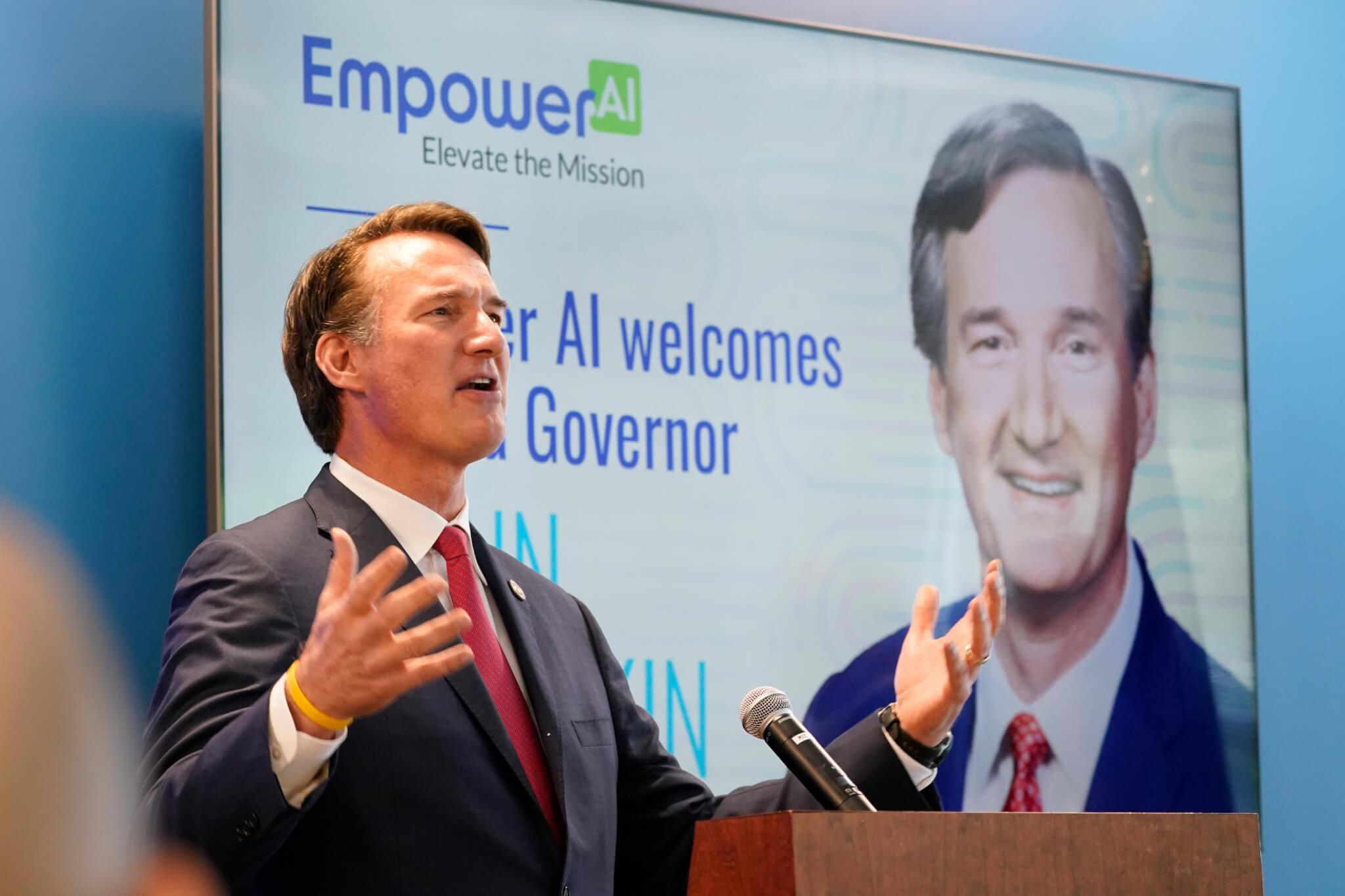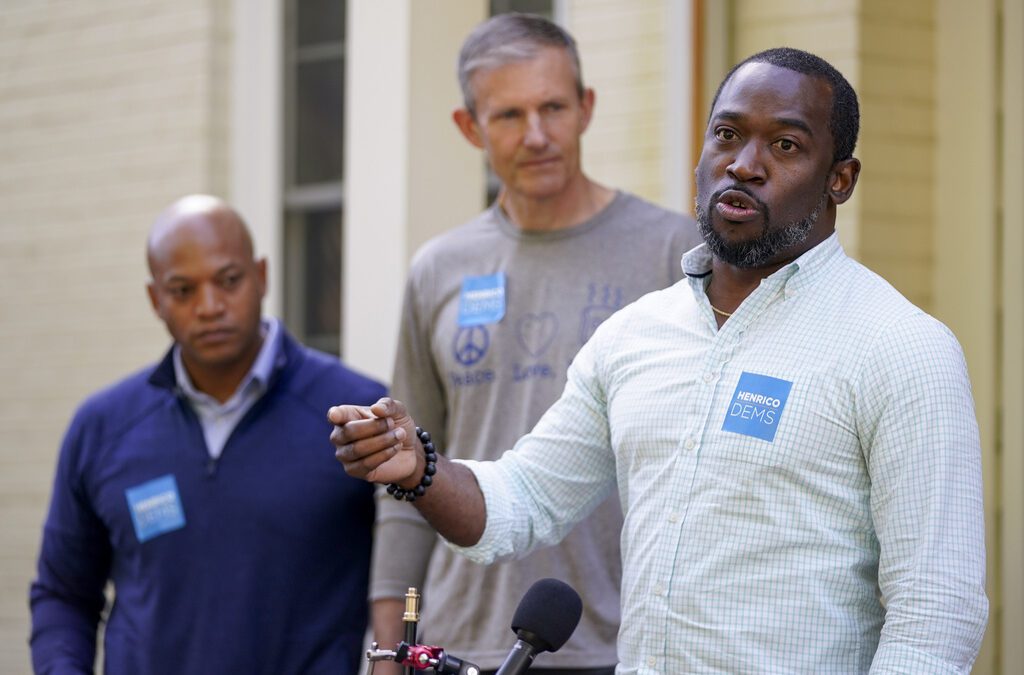
Virginia Gov. Glenn Youngkin gestures as he delivers remarks during opening ceremonies for the new offices of Empower AI Wednesday July 20, 2022, in Richmond, Va. (AP Photo/Steve Helber)
An executive directive aims to address the commonwealth’s teacher shortages.
Virginia’s pretty used to Gov. Glenn Youngkin signing executive orders when it comes to commonwealth classrooms.
During his first day in office on Jan. 15, Youngkin signed Executive Order One, which vowed to “end the use of inherently divisive concepts, including Critical Race Theory (CRT), and to raise academic standards.” Just to clarify, CRT isn’t part of the curriculum taught in Virginia schools, and never has been.
Shortly thereafter, and on the same day, he signed Executive Order Two, which did away with school mask mandates amid the ongoing COVID-19 pandemic — as long as parents agreed that that was the right choice for their children.
There was also a third school-based order signed on Jan. 15, Executive Order Four, which requested that the Attorney General conduct a full investigation into Loudoun County Public Schools over allegations of sexual assault.
Two executive directives were signed on Jan. 15, but they were the only of their kind until Sept. 1 when Youngkin visited Colonial Forge High School in Stafford, where he signed Executive Directive Three. The governor was also accompanied by Virginia Education Secretary Aimee Guidera and Virginia Superintendent for Public Instruction Jillian Balow.
The executive directive aims to address the commonwealth’s teacher shortages. The directive poses a nine-step method to remove obstacles that those seeking their own classroom might face.
The change would:
- Allow issuance of teaching and renewal licenses, including to teachers licensed in another state and retired teachers with lapsed licenses
- Utilize the Virginia Retirement System to ensure that all vacant K-12 teaching positions can be filled by retired teachers
- Form a group to develop legislative proposals around teacher licensure in hopes of recruiting more out of state teachers, retired teachers, career switchers, military veterans, and other professionals
- Target teacher recruitment and retention efforts to the communities and subject areas most in need
- Form a group to create a registered teacher occupation apprenticeship program to train and license new teachers, including paraprofessional educator
- Issue a statewide model policy to create childcare specialist apprenticeship opportunities for high school students
- Create policies and potential legislation to support childcare inside of schools, benefiting both teachers and families
- Inform all eligible teachers of the child care opportunities, including the Child Care Subsidy Program
- Expand and improve the annual survey of school divisions to identify critical, unfilled teaching positions, as well as develop an annual survey for all returning teachers to identify retention needs
Leading up to the announcement about the executive directive at the high school, Youngkin said: “We have a challenge. We have a challenge across our nation and we have a challenge here in the commonwealth. We have a shortage of teachers.”
Using the methods laid out in Executive Directive Three, Youngkin expressed hope that the initiatives would remove “as many obstacles as we can to address this near-term challenge, and also the long-term challenge, but making sure that we have in every classroom extraordinary teachers like the two I had a chance to visit with today.”
In response to the governor’s Executive Directive Three, Dr. James Fedderman, president of the Virginia Education Association (VEA), issued the following statement: “We all know that we have a teacher shortage in Virginia and the reasons for it aren’t a mystery to anyone who’s been paying attention: Our teachers are not only underpaid, but do their jobs under almost unbearably difficult working conditions. They don’t get the respect they deserve and they aren’t given the resources they need to most effectively serve our students.”
Fedderman further noted that if the new collective bargaining law for school employees was in place widely across Virginia, educators and local school leaders would be able to negotiate effective ways to fix teacher shortages in their communities.
“While Governor Youngkin’s Executive Directive today certainly has some ideas we can support, it doesn’t offer the type of serious investments that can really move the needle on this issue,” Fedderman said in part.
The VEA, through Fedderman, offered the following solutions:
- Pay educators competitive salaries to attract and retain high-quality staff
- Increase additional aid to high-poverty schools through the At-Risk Add-On
- Lift the “support cap,” which limits state aid for critical school positions
- Invest in community school models to break down barriers to education faced by many students
- Fully fund the Standards of Quality set by the Virginia Board of Education
Fedderman continued: “Our current budget surplus could be used effectively to solve this problem, which affects all Virginia’s citizens. By what he decides to do with those funds, our governor will show us if he truly values education and solving our teacher shortages.”
Politics

Biden administration bans noncompete clauses for workers
The Federal Trade Commission (FTC) voted on Tuesday to ban noncompete agreements—those pesky clauses that employers often force their workers to...

Democratic shakeup in Virginia primaries for governor, lieutenant governor
Richmond Mayor Levar Stoney quit his bid for governor and jumped into the race to be the Democratic nominee for lieutenant governor. The race for...
Local News

Virginia verses: Celebrating 5 poetic icons for National Poetry Month
There’s no shortage of great writers when it comes to our commonwealth. From the haunting verses of Edgar Allan Poe, who found solace in Richmond's...

Join the fun: Recapping Family Literacy Night’s storybook adventures
When’s the last time you read a book aloud with a loved one? If it’s difficult to answer that question, then maybe it’s time to dust off that TBR...





